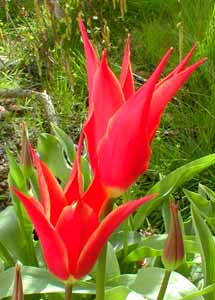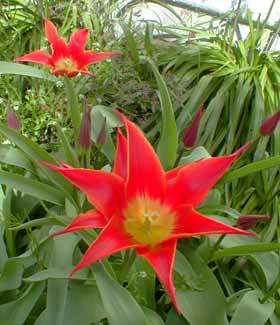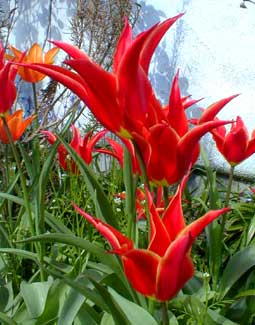
'Aladdin'
Lily-flowering Tulip
"The tulip & the butterfly
Appear in gayer coats than I:
Let me be dressed fine as I will,
Flies, worms, & flowers exceed me still."
-Isaac Watts
(1674-1748)
(1674-1748)
The hybrid lily-flowering tulip 'Aladdin' was introduced to gardening in 1942 & has long remained a standard variety. It grows to sixteen inches or so on long slim stems.
 In our garden these are in full flower just before the end of March, but mainly for all of April. In 2004 they lasted into a little part of May. But in 2005 only two of them returned, & those two had a much shorter presence, worn out by mid-April.
In our garden these are in full flower just before the end of March, but mainly for all of April. In 2004 they lasted into a little part of May. But in 2005 only two of them returned, & those two had a much shorter presence, worn out by mid-April.By contrast, two other lily-flowering tulips, 'Ballerina' planted right next to 'Aladdin' so experiencing the same conditions, & 'Doll's Minuet' growing in an alleyside tulip bed returned with considerable vigor. This has led me to assume 'Aladdin' is a mite fussier or sensitive & does not perennialize as reliably as some of the newer lily-flowering tulips.
The blooms have spidery recurved petals that are red with yellow edging. The name 'Aladdin' is supposed to evoke the red flames issuing from Aladdin's lamp, & this cultivar has been called "the genie of the garden."
The image of just this type of tulip was incorporated in Turkestani art by the 11th Century within a Sunni tribe known as the Seljuks, & found its way into the sacred poetry of Rumi in the 1200s. Tulips came to signify wealth, peace, elegance, love & power both political & godly during the Ottoman Empire.
The era called Lala Devri, the Tulip Period, ran from 1718-1730 during the progressive reign of Ahmet III. The Tulip Period was an age of scientific discovery, poetry, decorative arts, & fine architecture.
 Turkish arts obsessively depicted tulips, generally of pointed reflexed varieties that look like "flames," of the very sort we today categorize as Lily-flowering.
Turkish arts obsessively depicted tulips, generally of pointed reflexed varieties that look like "flames," of the very sort we today categorize as Lily-flowering.Despite that these were never the most common types of tulips, they were the artistic ideal, because of the symbolism that was reinforced most especially by Sufi poets, that tulips signified Divine Fire, Blood of Martyrs, or the Fiery Spirit of Allah that infuses creation & causes life.
Such a tulip is a physical manifestation of Divine Fire akin to Moses's burning bush, the self-same fire of all living. Therefore to cultivate tulips in one's garden is a sacred act, & to view such tulips with deepest appreciation is to approach the realm of the divine.
Its heritage begins with T. retroflexa (1902), itself of garden origin, crossed with Darwin tulips. 'Alladdin' perennializes in-place easily enough, but like so many hybrids does not otherwise naturalize.
Lily-flowering types of tulips have thin stems easily damaged by wind or harsh weather, so they can benefit from some protection. It may help to plant the bulbs as close together as two or three inches. Since they do not reproduce their own bulbs they can be considerably crowded never needing to be lifted to separate offsets.
When flowering first finishes, it can be useful to feed them a bit of bone meal or kelp, & do not clip back the foliage until it begins to yellow, giving each bulb the maximum opportunity to recharge for another year.